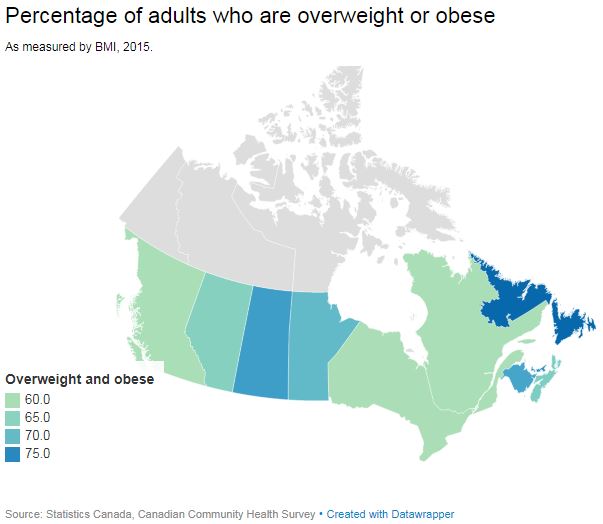Adult Canadians are still getting fatter, according to new data on obesity released by Statistics Canada.

And the weight gain isn’t evenly spread: Saskatchewan and the Atlantic provinces have a much higher percentage of obese adults than the Canadian average.
According to data from the Canadian Community Health Survey, 26.7 per cent of Canadians were obese in 2015, up from 23.1 per cent in 2004. The survey measured obesity as having a body mass index (BMI) of 30 or higher.

Using BMI to calculate obesity has been criticized as an approach, as comparing weight and height this way can sometimes incorrectly categorize athletic, muscular people as obese, among other errors. However, it’s still useful as a way to take a large-scale snapshot of a population, doctors have told Global News.
READ MORE: Don’t use BMI to measure your health, doctors say

Get weekly health news
Saskatchewan has Canada’s highest obesity rate, with 45.9 per cent of adults falling into that category. British Columbia has the lowest rate of adult obesity, at 21.4 per cent.
Saskatchewan’s obesity rate has climbed very quickly – growing from 30.8 per cent to 45.9 per cent between 2004 and 2015. This allowed it to overtake Newfoundland and Labrador, where the percentage of obese adults grew from 33.9 to 38.9 per cent in 11 years.
READ MORE: One in ten people worldwide are obese and the number keeps growing
However, Newfoundland and Labrador still has a higher proportion of adults above a normal BMI. Nearly 78 per cent of the adult population qualifies as overweight or obese. Overall, 61.3 per cent of all adult Canadians fit into those two categories.

There’s not a single province where a majority of adults are of normal or low weight. Ontario has the highest proportion, at 41.9 per cent.






Comments